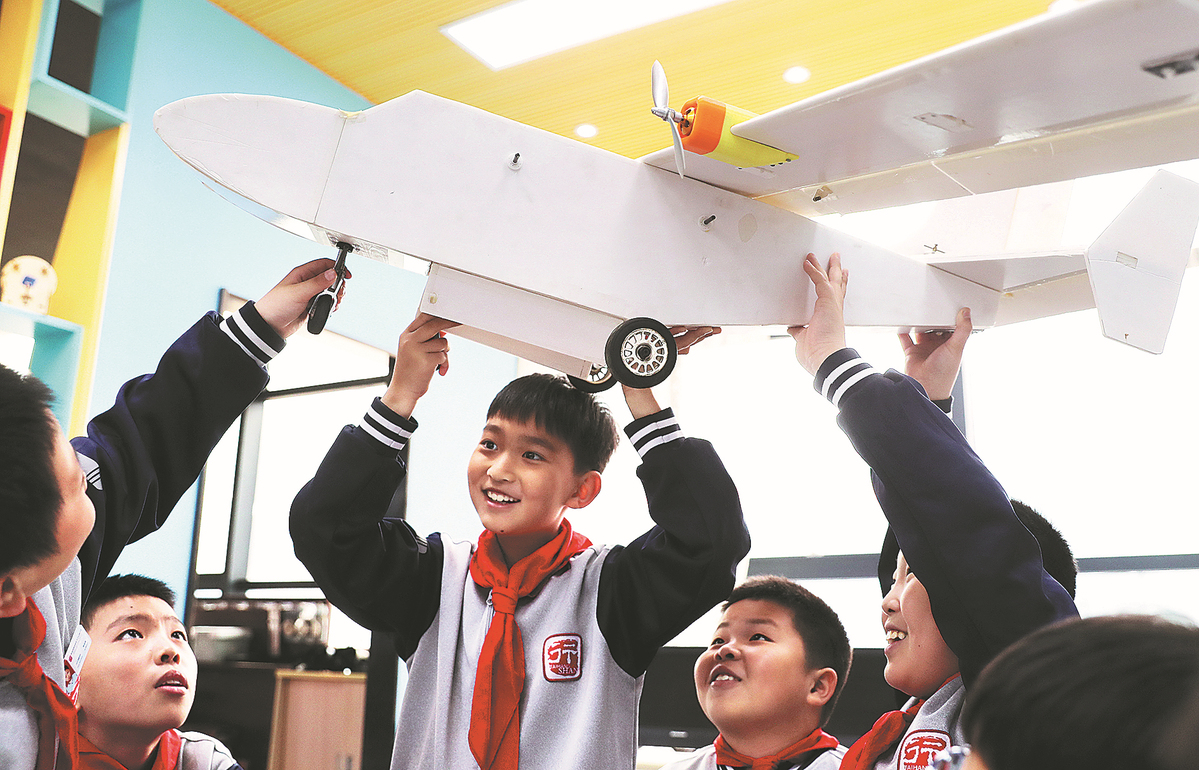Education
Schools prepare for fewer students as birth rate drops

Students show their product during a science fair at a primary school in Qingdao, Shandong province, on Monday. ZHANG JINGANG/FOR CHINA DAILY
Decline provides opportunity to reduce class size, pursue better development
China's low birth rate in recent years caused the number of kindergarten and primary school students in the country to drop last year.
Experts said while it is inevitable for some kindergartens and primary schools to close due to fewer pupils, it is also a good opportunity to downsize the number of students in each class and for schools to pursue higher quality development.
According to the latest figures from the Ministry of Education, the number of kindergarten pupils in China dropped by 1.8 million to 46.3 million last year, following a drop of 130,000 in 2021.
From 2004 to 2020, the number of kindergarten pupils increased for 17 consecutive years.
Meanwhile, the number of primary school students decreased last year for the first time since 2013, dropping by around 1 million to 107 million in 2022.
Despite the decline, China's investment in basic education continued to increase last year to enable more students to receive better schooling.
Ma Jiabin, deputy director of the Ministry of Education's department of basic education, said at a recent news conference that almost 90 percent of kindergarten pupils were studying at affordable kindergartens in 2022, up by 1.7 percentage points from a year earlier.
Moreover, the central government allocated 30 billion yuan ($4.36 billion) last year to improve the weak links in the teaching facilities of primary and middle school students, especially in central and western regions, he added.
At a news conference after the conclusion of the first session of the 14th National People's Congress, Premier Li Qiang said China's demographic dividend has not disappeared and its talent dividend is in the making.
"When assessing the demographic dividend, we shall not just look at the sheer size of the population but also look at the scale of the high-caliber workforce," he said.
More than 240 million people have received higher education in China, and the average length of education received by newcomers in the workforce has increased to 14 years, according to the premier.
Liu Changya, director of the Ministry of Education's department of development planning, said the gross enrollment rate at China's institutes of higher learning reached 59.6 percent last year, up 1.8 percentage points from a year earlier.
The number of students pursuing higher education hit 46.5 million last year, 2.25 million more than in 2021, he said.
To serve national development needs, more than half of undergraduate students enrolled last year were majoring in science, engineering, agriculture and medicine. Almost 60 percent of postgraduate students and more than 80 percent of doctoral students are studying those majors, he added.
At the National Education Work Conference held earlier this year, Minister of Education Huai Jinpeng said it is necessary to adjust the resource allocation of education based on changes in demographics and social structure.
Chen Zhiwen, editor-in-chief of the online education portal EOL, said it was the first time education authorities publicly discussed the impact of population change on education and how to adjust to such changes.
The number of newborns dropped to 9.56 million last year and has decreased for six consecutive years. Last year, the mainland's population dropped by 850,000, the first decline in more than six decades.
However, the country's quick urbanization drive also means it is still difficult for urban students to get into good public primary and middle schools, Chen said.
Qiao Jinzhong, an education professor at Beijing Normal University, said that based on his team's research, the number of primary and middle school students in 2035 is expected to decrease by around 30 million from that in 2020.
In the future, students will face less pressure getting into good schools, and the focus of education will shift from getting high grades to enriching students' knowledge, which is conducive to improving the quality of education, he said.
Moreover, to avoid large numbers of school closures, education authorities are encouraged to reduce the number of students in each class, he said.
Meanwhile, with an increased university enrollment rate and a decrease in eligible students, universities are forced to pursue differentiated and higher quality development, Qiao said.
Wang Dinghua, Party secretary of Beijing Foreign Studies University and a member of the National Committee of the Chinese People's Political Consultative Conference, told ThePaper.cn that he submitted a suggestion to this year's two sessions to optimize the allocation of teachers given the country's demographic shift.
In the next 15 years, the number of students at all levels of education will continue to drop, as will the demand for teachers.
However, the demand for music, art and sports teachers is still strong. Therefore, education authorities should prepare to better allocate teaching resources, he added.

Copyright 1995 - . All rights reserved. The content (including but not limited to text, photo, multimedia information, etc) published in this site belongs to China Daily Information Co (CDIC). Without written authorization from CDIC, such content shall not be republished or used in any form. Note: Browsers with 1024*768 or higher resolution are suggested for this site.
Registration Number: 130349









